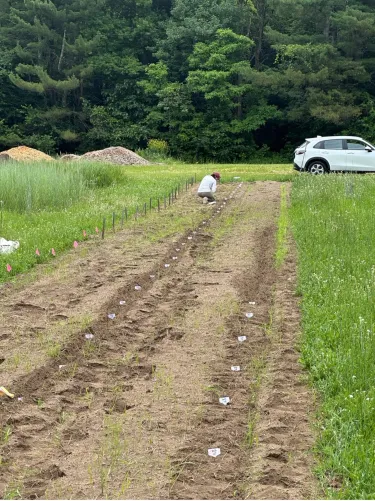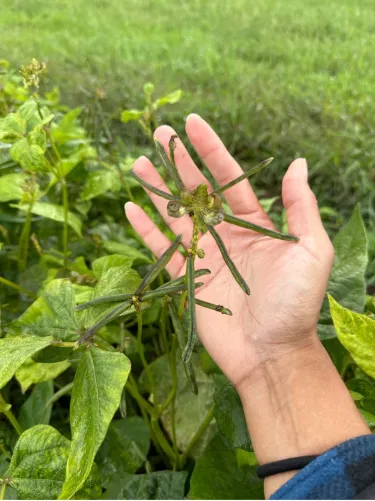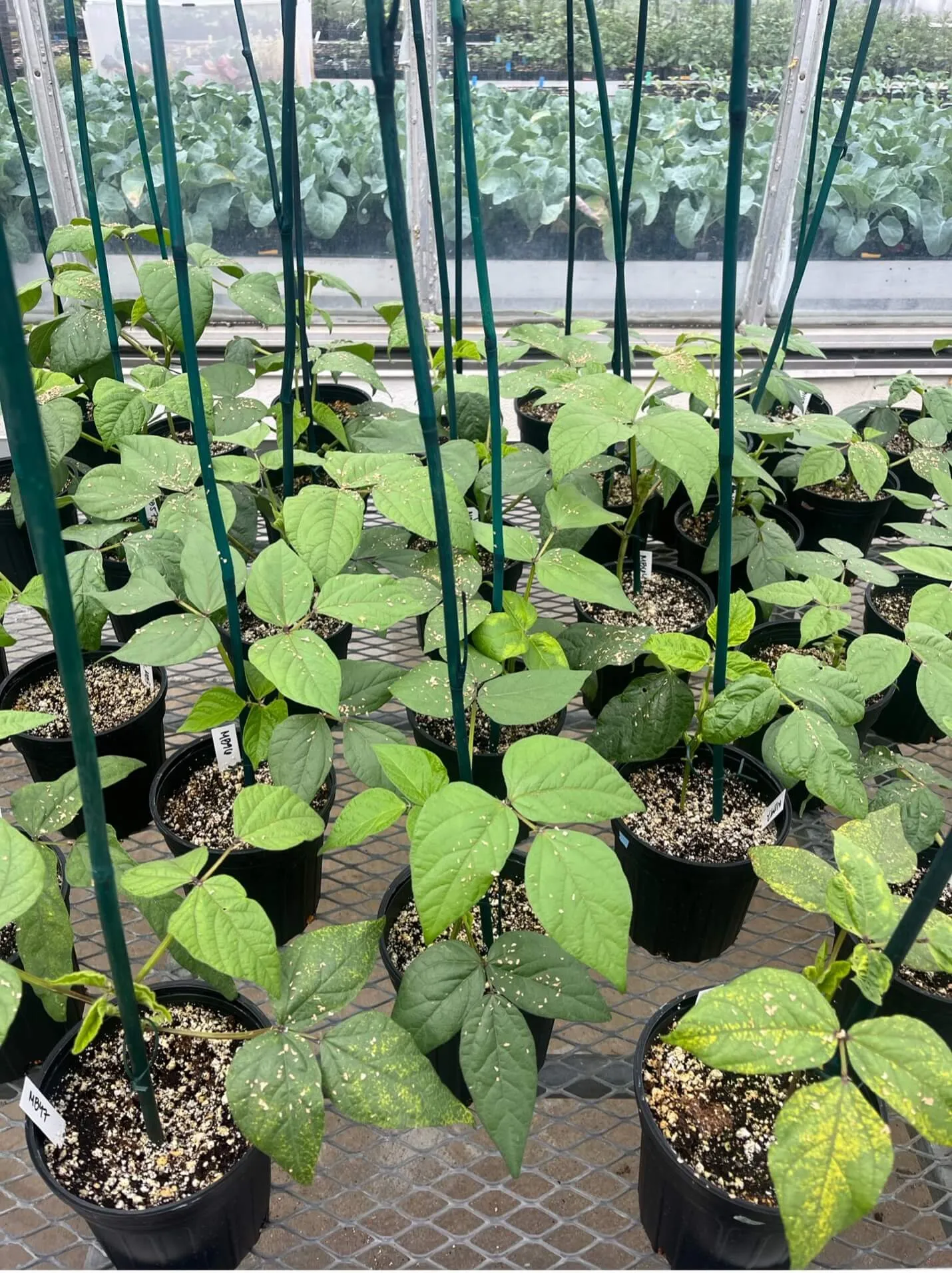As weather patterns shift and become more unpredictable, food security faces instability without adaptable farmers and adapted crop varieties. Instances of severe drought, flooding, wildfires, and more have increased infrequency over the last few decades. These severe weather events are a concern globally, particularly the Global South, but across the world, including in the Global North, disenfranchised and impoverished communities are at the most risk. While commercially important crops receive high levels of investments for research and development, this is not the case for crops that lack market demand, even if they possess other important characteristics that are important to growers and consumers such as taste, cooking qualities, and cultural connections. These minor crops are highly susceptible to the effects of severe weather, exacerbated by narrowing genetic variation, limited germplasm access, and a growing disconnect between farmers and breeders. The risks to these crops exacerbate national security risks through heightened food insecurity.
One strategy to address the lack of attention given to minor crops is through methods such as participatory plant breeding, by which farmers take an active role in the breeding and selection of contextually relevant crop varieties. Although researchers from CGIAR (Consultative Group for International Agricultural Research) are formally leading participatory plant breeding (PPB) programs for legumes and other non-cereal crops, few of these initiatives are farmer-led and across multiple regions. For plant breeders CGIAR and other programs, most of PPB projects have an international emphasis, particularly focused on high stress environments with little available inputs. While these efforts are no doubt a high priority due to high vulnerability to food insecurity and the effects of environmental change, a growing number of formal breeders also acknowledge the need for PPB within the United States to maintain diverse germplasm, which preserves stress resilience and increases sustainability. PPB prioritizing underutilized crops in collaboration with local communities can re-empower farmers to have more control over the breeding process, seed sourcing, and maintaining regional market preferences.

Planting mung bean summer 2024 at HREC. Photo Credit Jasmine Hart.
Our team consists of community-led organizations, seed companies, and academics; regardless of affiliation, all of us are committed to seed science, seed farmers, seed stewarding, and seed market expansion. The composition of our team includes representatives from Ujamaa Cooperative Farming Alliance (UCFA), Organic Seed Alliance (OSA), Utopian Seed Project, Experimental Farm Network, and University of Vermont (UVM). While all the collaborating organizations provide important support to strengthen the diversity and resilience of the seed sector, UCFA in particular warrants highlighting as a community organization of seed growers and farmers. UCFA is a growing network of over 200 farmers across the USA dedicated to uplifting vulnerable seed farmers and connecting disenfranchised communities back to the land and the crop varieties that provide cultural connections through seed cultivation and stewardship, as well as regional adaptation of culturally significant crops. UCFA is committed to variety improvement, market development, and the establishment of a national network of skilled diverse seed farmers. To support UCFA in this mission, our team was awarded a Small Grant from the Institute for Agroecology to conduct a novel participatory pre-breeding of traditionally relevant crops for vulnerable US-based communities.
Food is a central component of identity and connection to traditional values, often uniting communities in the face of colonization and aid in resistance to the westernization of diets. Almost all communities have at least one food that connects them to their heritage, which is crucial for the diaspora in places like the United States. Of particular importance are legumes and cereal crops, as they are global staples due to their nutritional density. However, many culturally important crop varieties remain under-researched, truncating their potential to increase weather and community resilience. With a focus on crops that can both buffer against the effects of changing weather patterns and enhance cultural connections, our team selected Mung bean (Vigna radiata (L.) R. Wilczek) and Sorghum (Sorghum bicolor (L.) Moench) due to their diverse uses, sustainability, and most importantly, community ties to the Asian-American and African-American diasporas. Sorghum is typically cultivated for grain, syrup, or forage, and mung bean is usually cultivated for sprouts, noodles, or for use in vegan substitutes like Just Egg. Beyond their market value, these crops were selected due to UCFA farmer interest for their multiuse nature, resilience, and traditional dishes/uses.
To engage in the PPB process, we used a citizen science approach, called triadic comparisons of technologies (Tricot), to assure that farmers themselves engaged in the research and informed decision-making. Tricot is used to assess a wide range of agricultural technologies, plant breeding and varietal selection in the case of this project. Each farmer is sent three varieties that are then ranked from best to worst on a specific trait, which with statistical analysis gives insight into farmer preferences. We selected a varied cohort of farmers across the continental US, with most farmers being located in the Mid-Atlantic, Vermont, or the West Coast regions. Cohort variation is necessary to adequately select resilient varieties, consequently participants include urban farmers, diverse demographic backgrounds, and various levels of farming experience. Farmer practices also differed from farm to farm: for example, we had some dryland farmers, some organic, as well as variation in fertilizer application methods and types. The farmers were sent three different varieties of mung bean, sorghum or both crops, depending on their growing region. Throughout the growing season, our cohort took data on basic traits like germination, vigor, disease resistance, reflected on their experiences growing each variety and any obstacles that were faced. OSA and UVM also grew out the same varieties as the cohort of farmers, to obtain replicated baseline data. In addition, OSA and UVM grew varieties of sorghum and mungbean obtained from USDA GRIN (Germplasm Resources Information Network) to evaluate for distribution this upcoming 2025 season to an even larger cohort. The varieties bulked were selected due to their potential for new market classes, non-commercial uses, and community interest for a regional adaptation. Despite a limited stock of commercially available mung bean cultivars, we distributed four varieties: Churta Marsh, Madagascar, OK2000, and Berken. Sorghum has a rich history in the Southern US, so we selected some of our favorites: Dorado, Della, Coral, Korjaj, and Kawanda.

Mung bean pods in the field at UVM 2024 HREC. Photo by Jasmine Hart
Data analysis is still in progress for both farmer data and UVM’s bulking panel. Preliminarily, Berken performed the best out of all of the other mung bean varieties and Della performed the best out of all of the other sorghum varieties. At UVM, we experienced heavy pest and disease pressure that limited overall productivity of the bulked panel and distributed varieties. Despite those challenges, Golden Mung (PI 145943) was quite prolific with great grain yield and exhibited no signs of disease or pest pressure. We are currently in the midst of a secondary bulking event to produce clean seed to send to our new cohort of growers.
This initial pilot season we have learned more about ourselves, this process, and general excitement for this initiative. This upcoming season we will expand to a larger cohort of growers, establish a planning committee with farmer representatives, and reexamine breeding goals. For example, we are exploring mung beans for sprout production and moving away from syrup sorghum types to low tannin sorghum for animal feed, all based on conversations with our farmer cohort and partners. Participatory plant breeding is a tool for us to weather the onslaught of the storms - climate instability, food insecurity, and loss of connection to heritage.
If you would like to be a grower for us this upcoming season or in the future, contact Jasmine Hart at jasmine.hart@uvm.edu.
